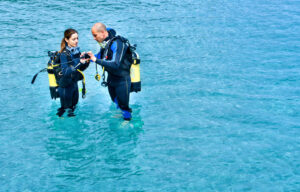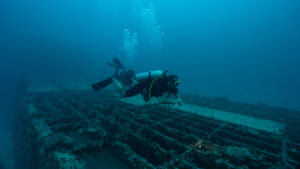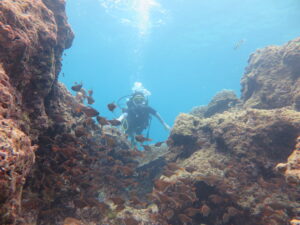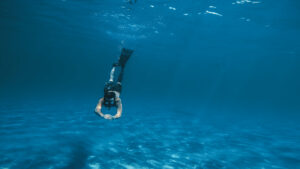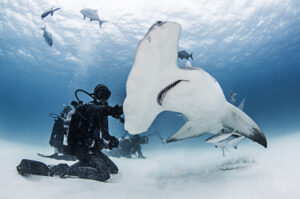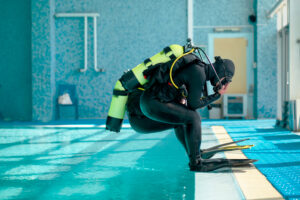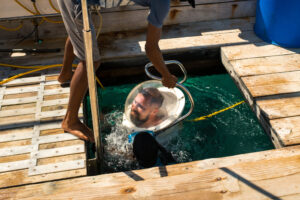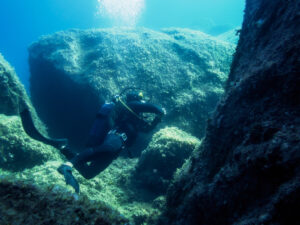What is a Squeeze?
In scuba diving, “squeeze” refers to the various types of barotrauma that can occur when air spaces within the body are subjected to pressure changes during a dive. As divers descend and ascend, the pressure exerted by the surrounding water changes, which can cause discomfort or injury if the pressure within the body’s air spaces does not equalize properly. Understanding and managing squeeze is crucial for the safety and comfort of divers, as it can affect various parts of the body including the ears, sinuses, teeth, mask area, and even the suit.
Definition and Types of Squeeze
Squeeze in scuba diving is essentially a pressure imbalance issue. When a diver descends, the pressure of the water around them increases. This increase in pressure can compress air spaces within the body if they are not equalized to match the external pressure. Failure to equalize these pressures can lead to barotrauma, commonly referred to as squeeze.
One common type of squeeze is the mask squeeze. This occurs when a diver’s mask is not equalized properly during descent, causing a vacuum effect that can result in facial bruising and eye damage. To prevent this, divers must exhale through their nose into the mask to equalize the pressure.
Ear squeeze, also known as barotitis media, is another prevalent form of squeeze. It happens when the pressure in the middle ear fails to equalize with the external water pressure. Symptoms include ear pain, hearing loss, and in severe cases, a ruptured eardrum. Equalization techniques such as the Valsalva maneuver (pinching the nose and gently blowing) can help prevent ear squeeze.
Sinus squeeze occurs when the sinus cavities fail to equalize, causing sharp pain in the forehead or cheek areas, and potentially leading to nosebleeds. Proper equalization techniques and avoiding diving with congested sinuses can mitigate this risk.
Tooth squeeze, or barodontalgia, is a less common but painful condition where trapped air in dental work or cavities expands and contracts with pressure changes, causing tooth pain. Regular dental check-ups and addressing any dental issues before diving can help prevent this type of squeeze.
Suit squeeze happens with dry suits if the air inside the suit is not properly managed. As the diver descends, the suit can compress, leading to discomfort and restricted movement. Adding air to the suit through the suit’s inflator valve can alleviate this pressure.
Physiology Behind Squeeze
The physiology behind squeeze is rooted in the principles of pressure and volume changes as described by Boyle’s Law. Boyle’s Law states that the volume of a gas is inversely proportional to the pressure exerted on it. As a diver descends, the increasing water pressure causes the volume of air in body cavities and equipment to decrease. Without proper equalization, this pressure difference can cause significant discomfort or injury.
When divers descend, the pressure of the water increases by approximately one atmosphere for every 10 meters (33 feet) of depth. This pressure increase affects all air-filled spaces in the body, including the ears, sinuses, lungs, and any trapped air pockets in dental work or equipment. Equalizing these spaces is essential to avoid squeeze.
The middle ear is particularly susceptible to pressure changes. Normally, the Eustachian tube allows air to pass between the middle ear and the throat to equalize pressure. However, if this tube is blocked or if equalization is not performed correctly, the pressure difference can cause the eardrum to bulge inward or outward, leading to pain and potential rupture.
Similarly, the sinuses, which are air-filled spaces in the skull, need to equalize pressure. Blocked sinus passages due to congestion or other factors can prevent this, resulting in a sinus squeeze. This can cause pain and potential damage to the sinus tissues.
Mask squeeze occurs because the mask covers the nose and eyes, creating an air pocket that needs to be equalized. If a diver does not exhale through their nose into the mask to balance the pressure, the mask can be pushed onto the face, causing bruising and discomfort.
Symptoms and Diagnosis
Recognizing the symptoms of squeeze is crucial for timely intervention and prevention of further injury. Each type of squeeze has its specific symptoms, which can vary in severity depending on the extent of the pressure imbalance.
Mask squeeze typically manifests as red marks around the eyes and forehead, accompanied by bruising and sometimes bleeding in the eyes. The condition is usually identified by the telltale bruising and discomfort experienced by the diver post-dive.
Ear squeeze symptoms include ear pain, a feeling of fullness in the ear, dizziness, and hearing loss. In severe cases, there may be fluid or blood discharge from the ear if the eardrum ruptures. Diagnosis is often based on the diver’s report of symptoms and a physical examination of the ear.
Sinus squeeze can cause sharp pain in the forehead or face, nosebleeds, and a sensation of pressure in the affected sinus cavities. Diagnosis involves examining the nasal passages and sinuses, often with imaging techniques like X-rays or CT scans to assess the extent of the blockage or injury.
Tooth squeeze presents as sudden, sharp pain in a specific tooth, often worsening with changes in depth. The diagnosis usually involves a dental examination to identify any air pockets in fillings, cavities, or other dental work that could be responsible for the pain.
Suit squeeze is diagnosed based on the diver’s experience of discomfort and restricted movement due to the compression of the dry suit. Visual inspection of marks or bruises on the skin where the suit has pressed can confirm the diagnosis.
Prevention of Squeeze
Preventing squeeze involves a combination of proper techniques, equipment checks, and health considerations. Ensuring that the body’s air spaces and equipment are equalized to the surrounding pressure is the primary preventive measure.
For mask squeeze, divers should ensure their mask fits properly and practice exhaling through the nose into the mask during descent. This keeps the pressure inside the mask equal to the outside pressure, preventing the vacuum effect.
Preventing ear squeeze involves mastering equalization techniques. The Valsalva maneuver, Toynbee maneuver (swallowing while pinching the nose), and other methods can help open the Eustachian tubes and equalize ear pressure. Divers should start equalizing before feeling discomfort and continue regularly throughout the descent.
To avoid sinus squeeze, divers should ensure they are free of nasal congestion before diving. Using decongestants or nasal sprays can help, but divers should consult a doctor to ensure these are safe for their specific health conditions. Proper equalization techniques also apply to the sinuses.
Regular dental check-ups are crucial to prevent tooth squeeze. Any dental work that could trap air, such as fillings or crowns, should be checked and maintained properly. If tooth pain occurs during a dive, ascending to a shallower depth can alleviate the pressure and pain.
For dry suit divers, preventing suit squeeze involves adding air to the suit through the inflator valve during descent. This maintains a layer of air between the suit and the body, preventing the suit from compressing too tightly. Ensuring the suit fits properly and is in good condition is also important.
Management and Treatment
Managing squeeze involves immediate and longer-term measures to address the symptoms and prevent further damage. Immediate first aid and medical intervention can help mitigate the effects of squeeze.
For mask squeeze, the first step is to avoid further diving until the symptoms subside. Applying cold compresses to the bruised areas can reduce swelling and discomfort. Most mask squeeze cases resolve on their own without the need for medical treatment.
Ear squeeze management starts with stopping the dive and ascending slowly to reduce pressure. Applying warm compresses and taking over-the-counter pain relievers can help alleviate pain. If symptoms persist or there is a suspicion of a ruptured eardrum, seeking medical attention is essential. A healthcare professional can assess the damage and provide appropriate treatment, which may include antibiotics to prevent infection.
Sinus squeeze requires similar initial steps: stopping the dive and ascending. Over-the-counter decongestants and pain relievers can help manage symptoms. Persistent or severe cases should be evaluated by a healthcare professional, who may recommend imaging studies and prescribe medications to reduce inflammation and facilitate drainage.
Tooth squeeze treatment involves ascending to relieve the pressure and then seeing a dentist to address the underlying dental issue. This may involve repairing or replacing faulty dental work to prevent recurrence.
For suit squeeze, ascending and adding air to the suit immediately can relieve the pressure. Divers should check their equipment to ensure it functions correctly and make any necessary adjustments or repairs.
Case Studies
Historical and notable cases of squeeze provide valuable insights into the importance of proper techniques and awareness. These real-world examples highlight the potential severity of squeeze and the lessons learned from these incidents.
One well-documented case involved a diver who experienced severe ear squeeze due to a blocked Eustachian tube. Despite multiple attempts to equalize, the diver continued to descend, resulting in a ruptured eardrum. This case underscores the importance of not pushing through discomfort and ensuring equalization before proceeding further.
Another case involved a diver who neglected to equalize their mask during a rapid descent. The result was significant facial bruising and subconjunctival hemorrhages in the eyes. This incident highlights the need for proper mask fit and consistent equalization practices.
A diver with untreated sinus congestion experienced a sinus squeeze that led to severe pain and nosebleeds. This case illustrates the risks of diving with existing health issues and the importance of pre-dive health assessments.
A tooth squeeze incident involved a diver with an undiagnosed air pocket under a dental crown. The diver experienced intense tooth pain during descent, forcing an emergency ascent. The subsequent dental examination revealed the cause, leading to necessary dental repairs.
Lastly, a dry suit diver experienced suit squeeze due to a malfunctioning inflator valve. The diver had not conducted a thorough equipment check before the dive, resulting in significant discomfort and restricted movement underwater. This case emphasizes the importance of pre-dive equipment checks and ensuring all gear functions correctly.
Key Takeaways
Understanding and managing squeeze is crucial for safe and comfortable scuba diving. Proper equalization techniques, regular equipment checks, and addressing health issues before diving are essential preventive measures. Recognizing symptoms early and taking appropriate action can prevent serious injuries. Divers should prioritize education on squeeze to ensure a safe underwater experience.


